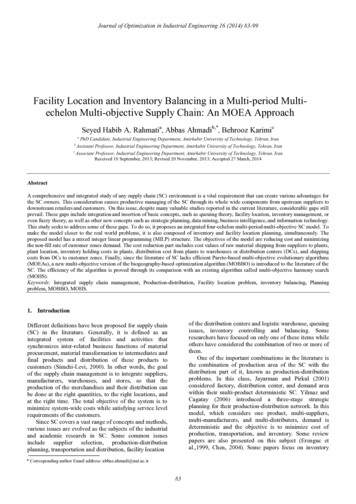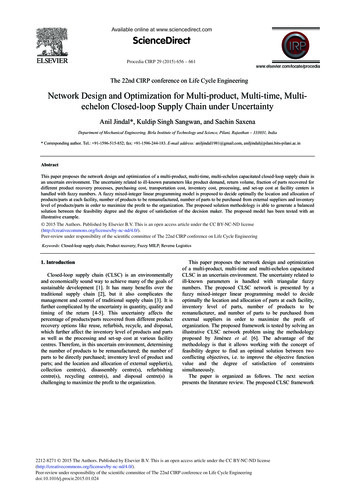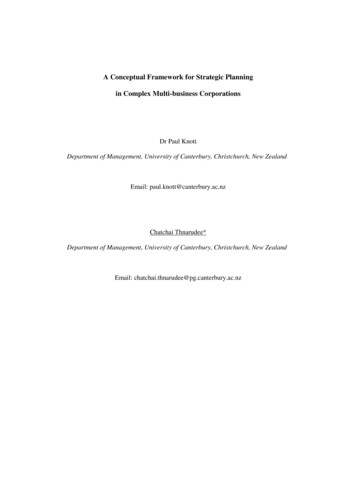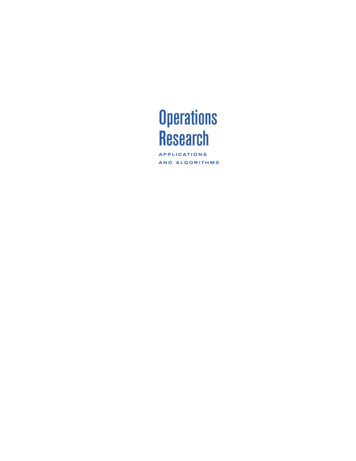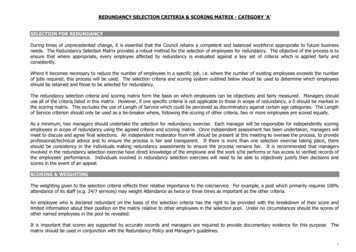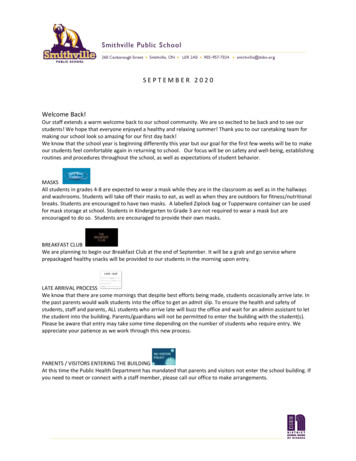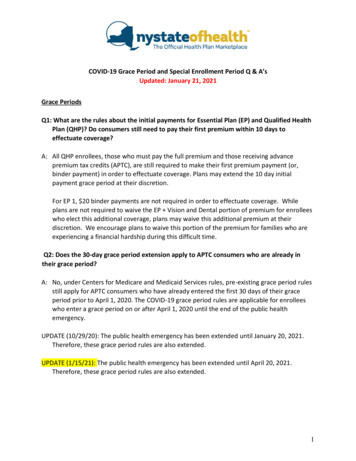
Transcription
9Multi-period PlanningProblems9.1 IntroductionOne of the most important uses of optimization is in multi-period planning. Most of the problems wehave considered thus far have been essentially one-period problems. The formulations acted as ifdecisions this period were decoupled from decisions in future periods. Typically, however, if we producemore of a certain product this period than required by a constraint, that extra production will not beworthless, but can probably be used next period.These interactions between periods can be represented very easily within optimization models. Infact, most large linear programs encountered in practice are multi-period models. A common synonymfor “multi-period” is “dynamic” (e.g., a multi-period LP may be referred to as a dynamic model).In some applications, the need to represent the multi-period aspects is quite obvious. One setting inwhich multi-period LP has been used for a number of years is in the manufacture of cheese. Productiondecisions must be made monthly or even weekly. The production time for many cheeses, however, maybe months. For example, Parmesan cheese may need to be stored in inventory for up to ten months. WhatAmericans call Swiss cheese may take from two to four months. The various grades of cheddar obtaineddepend upon the number of weeks held in storage. Sharp cheddar may be aged up to a year in storage.Clearly, in such applications, the multi-period aspect of the model is the important feature.Models for planning over time represent the real world by partitioning time into a number of periods.The portion of the model corresponding to a single period might be some combination of product mix,blending, and other models. These single-period or static models are linked by:1.2.A link or inventory variable for each commodity and period. The linking variablerepresents the amount of commodity transferred from one period to the next.A “material balance” or “sources uses” constraint for each commodity and period. Thesimplest form of this constraint is “beginning inventory production ending inventory goods sold”.Multi-period models are usually used in a rolling or sliding format. In this format, the model issolved at the beginning of each period. The recommendations of the solution for the first period areimplemented. As one period elapses and better data and forecasts become available, the model is slidforward one period. The period that had been number 2 becomes number 1, etc., and the whole process205
206Chapter 9 Multi-period Planning Problemsis repeated. When using a model in this sliding fashion, a practical problem is that, as the new informationbecomes available, this period’s “optimal” solution may be drastically different from the previousperiod’s “optimal” solution. The people who have to implement the solution may find this disconcerting.The scheduling system is said to suffer from nervousness. An approach that has been used successfullyin scheduling ships, scheduling plant closings/openings, and scheduling production of breakfast cereal,see Brown, Dell, and Wood (1997), is to specify a “reference” solution (e.g., the previous period’ssolution). One then defines a secondary objective of minimizing the deviation of the current solutionfrom the reference solution. If one puts zero weight on the secondary objective, then one gets thetheoretically optimal solution. If one puts an extremely high weight on the secondary objective, then onesimply gets the reference solution returned. If a modest weight is placed on the secondary objective, thenone gets a solution that is a good compromise between low cost as measured by standard accounting,but is also close to the reference solution.There is nothing sacred about having all periods of the same length. For example, when a petroleumcompany plans production for the coming year, it is sensible to have the periods correspond to theseasons of the year. One possible partition is to have the winter period extend from December 1 to March15, the spring period extend from March 16 to May 15, the summer period extend from May 16 toSeptember 15, and the autumn period extend from September 16 to November 30.Some companies, such as forest product or mineral resource based companies, plan as much as 50years into the future. In such a case, one might have the first two periods be one year each, the nextperiod be two years, the next two periods three years each, the next two periods five years each, and thefinal three periods ten years each.Inter-period interactions are usually accounted for in models by the introduction of inventorydecision variables. These variables “link” adjacent periods. As an example, suppose we have a singleexplicit decision to make each period. Namely, how much to produce of a single product. Call thisdecision variable for period j, Pj. Further, suppose we have contracts to sell known amounts of thisproduct, dj, in period j. Define the decision variable Ij as the amount of inventory left over at the end ofperiod j. By this convention, the beginning inventory in period j is Ij-1. The LP formulation will thencontain one “sources of product uses of product” constraint for each period. For period 2, the sourcesof product are beginning inventory, I1, and production in the period, P2. The uses of product are demand,d2, and end of period inventory, I2. For example, if d2 60 and d3 40, then the constraint for period 2is:I1 P2 60 I2orI1 P2 I2 60.The constraint for period 3 is:I2 P3 I3 40.Notice how I2 “links” (i.e., appears in both the constraints for periods 2 and 3).In some problems, the net outflow need not exactly equal the net inflow into the next period. Forexample, if the product is cash, then one of the linking variables may be short-term borrowing or lending.For each dollar carried over from period 2 by lending, we will enter period 3 with 1.05 if the interestrate is 5% per period.On the other hand, if the “product” is workforce and there is a predictable attrition rate of 10% perperiod, then the above two constraints would be modified to:.90I1 P2 I2 60.90I2 P3 I3 40.In this case, Pi is the number hired in period i.
Multi-period Planning Problems Chapter 9207The following example provides a simplified illustration of a single-product, multi-period planningsituation.9.2 A Dynamic Production ProblemA company produces one product for which the demand for the next four quarters is predicted to be:SpringSummerAutumnWinter20305060Assuming all the demand is to be met, there are two extreme policies that might be followed:1.2.“Track” demand with production and carry no inventory.Produce at a constant rate of 40 units per quarter and allow inventory to absorb thefluctuations in demand.There are costs associated with carrying inventory and costs associated with varying the productionlevel, so one would expect the least-cost policy is probably a combination of (1) and (2) (i.e., carry someinventory, but also vary the production level somewhat).For costing purposes, the company estimates changing the production level from one period to thenext costs 600 per unit. These costs are often called “hiring and firing” costs. It is estimated thatcharging 700 for each unit of inventory at the end of the period can accurately approximate inventorycosts. The initial inventory is zero and the initial production level is 40 units per quarter. We requirethese same levels be achieved or returned to at the end of the winter quarter.We can now calculate the production change costs associated with the no-inventory policy as: 600 (20 10 20 10 20) 48,000.On the other hand, the inventory costs associated with the constant production policy is: 700 (20 30 20 0) 49,000.The least cost policy is probably a mix of these two pure policies. We can find the least-cost policyby formulating a linear program.9.2.1 FormulationThe following definitions of variables will be useful:PiIiUiDi number of units produced in period i, for i 1, 2, 3, and 4; units in inventory at the end of period i; increase in production level between period i 1 and i; decrease in production level between i 1 and i.The Pi variables are the obvious decision variables. It is useful to define the Ii, Ui, and Di variables,so we can conveniently compute the costs each period.To minimize the cost per year, we want to minimize the sum of inventory costs: 700 I1 700 I2 700 I3 700 I4plus production change costs: 600 U1 600 U2 600 U3 600 U4 600 U5 600 D1 600 D2 600 D3 600 D4 600 D5.
208Chapter 9 Multi-period Planning ProblemsWe have added a U5 and a D5 in order to charge for the production level change back to 40, if neededat the end of the 4th period.9.2.2 ConstraintsEvery multi-period problem will have a “material balance” or “sources uses” constraint for eachproduct per period. The usual form of these constraints in words is:beginning inventory production ending inventory demand.Algebraically, these constraints for the problem at hand are:P1 I1I1 P2 I2I2 P3 I3I3 P4 20 30 50 60Notice I4 and I0 do not appear in the first and last constraints, because initial and ending inventoriesare required to be zero.If the formulation is solved as is, there is nothing to force U1, D1, etc., to be greater than zero.Therefore, the solution will be the pure production policy. Namely, P1 20, P2 30, P3 50, P4 60.This policy implies a production increase at the end of every period, except the last. This suggests a wayof forcing U1, U2, U3, and U4 to take the proper values is to append the constraints:U1 P1 40U2 P 2 P 1U3 P 3 P 2U4 P4 P3.Production decreases are still not properly measured. An analogous set of four constraints shouldtake care of this problem, specifically:D1 40 P1D2 P 1 P 2D3 P 2 P 3D4 P3 P4.To incorporate the requirement that the production level be returned to 40 at the end of the winterquarter, we add the variables U5 and D5 to measure changes at the end of the last quarter. U5 and D5 areforced to take on the right values with the constraints:U5 40 P4D5 P4 40.Before moving on, we will note the production-change constraints can be reduced to 5 constraintsfrom the 10 implied by the above form. The key observation is two constraints such as:U2 P 2 P 1D2 P 1 P 2can be replaced by the single constraint:U 2 D 2 P 2 P 1.
Multi-period Planning Problems Chapter 9209The argument is more economic than algebraic. The purpose with either formulation is to forceU2 P2 P1 if P2 P1 0 and D2 P1 P2 if P1 P2 0. From economics, you can argue that, at theoptimal solution, you will find at most one of U2 and D2 are greater than 0 under either formulation. Ifboth U2 and D2 are greater than 0 under the second formulation, then both can be reduced by an equalamount. Thus, reducing costs without violating any constraints.The complete formulation is:MODEL:!Minimize inventory workforce change costs;MIN 700 * I1 700 * I2 700 * I3 700 * I4 600 * U1 600 * U2 600 * U3 600 * U4 600 * D1 600 * D2 600 * D3 600 * D4 600 * U5 600 * D5;!Initial conditions on inventory & production;[CNDBI] I0 0;[CNDBP] P0 40;!Beginning inventory production demand ending inventory;[INV1] I0 P1 20 I1;[INV2] I1 P2 30 I2;[INV3] I2 P3 50 I3;[INV4] I3 P4 60 I4;!Change up - change down prod. this period - prod. prev. period;[CHG1] U1 - D1 P1 - P0;[CHG2] U2 - D2 P2 - P1;[CHG3] U3 - D3 P3 - P2;[CHG4] U4 - D4 P4 - P3;[CHG5] U5 - D5 P5 - P4;!Ending conditions;[CNDEI] I4 0;[CNDEP] P5 40;ENDThe solution is:Optimal solution found at step:7Objective value:43000.00VariableValueReduced 00
210Chapter 9 Multi-period Planning lack or 0000Dual 0600.0000-1650.000600.0000We see the solution is a mixed policy:P1 P2 25;P3 P4 55.The mixed policy found by LP is 5,000 cheaper than the best pure policy.9.2.3 Representing Absolute ValuesYou may be tempted to represent the production-change costs in the above model by the expression:600 *( @ABS( P1 – P0) @ABS( P2 – P1) @ABS(P5 – P4));This is mathematically correct, but computationally unwise, because it converts a linear programinto a nonlinear program. Nonlinear programs are always more time consuming to solve. We haveexploited the following result to obtain a linear program from an apparently nonlinear program. Subjectto a certain condition, any appearance in a model of a term of the form:@ABS ( expression)can be replaced by the term U D, if we add the constraint:U – D expression.The “certain condition” is that the model must be such that a small value of @ABS (expression) ispreferred to a large value for @ABS (expression). The result is, if expression is positive, then U will beequal to expression, whereas, if expression is negative, then D will equal the negative of expression.9.3 Multi-period Financial ModelsIn most multi-period planning problems, the management of liquid or cash-like assets is an importantconsideration. If you are willing to consider cash holdings as an inventory just like an inventory of any
Multi-period Planning Problems Chapter 9211other commodity, then it is a small step to incorporate financial management decisions into amulti-period model. The key feature is, for every period, there is a constraint that effectively says,“sources of cash uses of cash 0”. The following simple, but realistic, example illustrates the majorfeatures of such models.9.3.1 Example: Cash Flow MatchingSuppose, as a result of a careful planning exercise, you have concluded that you will need the followingamounts of cash for the current plus next 14 years to meet certain commitments:Year:01234567891011121314Cash (in 1,000s)101112141517192022242629313336A common example where such a projection is made is in a personal injury lawsuit. Both partiesmay reach an agreement that the injured party should receive a stream of payments such as above or itsequivalent. Other examples where the above approach has been used is in designing bond portfolios tosatisfy cash needs for a pension fund, or for so-called balance sheet defeasance where one kind of debtis replaced by another having the same cash flow stream.For administrative simplicity in the personal injury example, both parties prefer an immediate singlelump sum payment that is “equivalent” to the above stream of 15 payments. The party receiving thelump sum will argue that the lump sum payment should equal the present value of the stream using alow interest rate such as that obtained in a very low risk investment (i.e., a government guaranteedsavings account). For example, if an interest rate of 4% is used, the present value of the stream ofpayments is 230,437. The party that must pay the lump sum, however, would like to argue for a muchhigher interest rate. To be successful, such an argument must include evidence that such higher interestrate investments are available and are no riskier than savings accounts. The investments usually offeredare government securities. Generally, a broad spectrum of such investments is available on a given day.For simplicity, assume there are just two such investments available with the following features:PrincipalCurrentYearlyYears toRepayment atSecurityCostReturnMaturityMaturity12 980 965 60 65512 1000 1000The paying party will offer a lump sum now with a recommendation of how much should be investedin securities 1 and 2 and in savings accounts, such that the yearly cash requirements are met with theminimum lump sum payment.The following decision variables are useful in solving this problem:B1B2SiL amount invested now in security 1, measured in “face value amount”,amount invested now in security 2, measured in “face value amount”,amount invested into a savings account in year i, andinitial lump sum.
212Chapter 9 Multi-period Planning ProblemsThe objective function will be to minimize the initial lump sum. There will be a constraint for eachyear that forces the cash flows to net to zero. If we assume idle cash is invested at 4 percent in a savingsaccount and all amounts are measured in 1000’s, then the formulation is:MIN L;L - 0.98 * B1 - 0.965 * B2 - S0 10;0.06 * B1 0.065 * B2 1.04 * S0 - S10.06 * B1 0.065 * B2 1.04 * S1 - S20.06 * B1 0.065 * B2 1.04 * S2 - S30.06 * B1 0.065 * B2 1.04 * S3 - S41.06 * B1 0.065 * B2 1.04 * S4 - S50.065 * B2 1.04 * S5 - S6 19;0.065 * B2 1.04 * S6 - S7 20;0.065 * B2 1.04 * S7 - S8 22;0.065 * B2 1.04 * S8 - S9 24;0.065 * B2 1.04 * S9 - S10 26;0.065 * B2 1.04 * S10 - S11 29;1.065 * B2 1.04 * S11 - S12 31;1.04 * S12 - S13 33;1.04 * S13 - S14 36; 11;12;14;15;17;The PICTURE of the constraint coefficients gives a better appreciation of the structure of theproblem. An A represents numbers bigger than 1.0, but less than 10.0. Numbers 10 or larger, but lessthan 100.0, are represented by a B. Numbers less than 1.0, but at least 0.1, are represented by a T.Numbers less than 0.1, but at least 0.01, are represented by a U:1:2:3:4:5:6:7:8:9:10:11:12:13:14:15:16:S S S S SB B S S S S S S S S S S 1 1 1 1 1L 1 2 0 1 2 3 4 5 6 7 8 9 0 1 2 3 411-T-T-1U U A-1U UA-1U UA-1U UA-1A UA-1UA-1UA-1UA-1UA-1UA-1UA-1AA-1A-1A-1MIN A B B B B B B B B B B B B B B
Multi-period Planning Problems Chapter 9213Notice in row 7, B1 has a coefficient of 1.06. This represents the principal repayment of 1000 plusthe interest payment of 60 measured in 1000’s. Variable S14 (investment of funds in a savings accountafter the final payment is made) appears in the problem even though at first you might think it useless toallow such an option. S14 is effectively a surplus cash variable in the final period. Nevertheless, it is notunusual for the solution that minimizes the lump sum payment to have cash left over at the end of theperiod. This is because a bond may be the most economical way of delivering funds to intermediateperiods. This may cause the big principal repayment at the end of a bond’s life to “overpay” the mostdistant periods. The solution is:Optimal solution found at step:14Objective value:195.6837VariableValueReduced 368Of the 195,683.70 lump sum payment, 10,000 goes to immediate requirements, 4,804.50 goesinto a savings account, and 0.98 95,795.77 0.965 90,154.74 180,879.20 goes into longer-termsecurities. Considering a wide range of investments rather than just savings accounts has reduced theamount of the lump sum payment by about 34,750, or 15%.In actual solutions, one may find a major fraction of the lump sum is invested in a single security.For example, appending the following constraint limits the amount invested in security 1 to half theinitial lump sum:0.98 B1 0.5 L 0.An additional complication may arise due to integrality requirements on the B1 and B2 investments.For example, bonds can be bought only in 1000 increments. Generally, with a modest amount ofjudgment, the fractional values can be rounded to neighboring integer values with no great increase inlump sum payment. For example, if B1 and B2 are set to 96 and 90 in the previous example, the total costincreases to 195,726.50 from 195,683.70. When this is done, S14 becomes nonzero. Specifically, thelast period is overpaid by about 40.
214Chapter 9 Multi-period Planning ProblemsA sets version that places an integrality requirement on the bond purchase variables is:MODEL:! Name PBOND, Bond portfolio/ cash matching problem: Given cash needsin each future period, what collection of bonds should we buy to coverthese needs?;SETS:BOND/1.2/ : MATAT, ! Matures at period;PRICE, ! Purchase price;CAMNT, ! Coupon payout each period;BUY; ! Amount to buy of each bond;PERIOD/1.15/:NEED,! Cash needed each period;SINVEST; ! Short term investment each period;ENDSETSDATA:STRTE .04;! Short term interest rate;MATAT 6,13;! Years to maturity;PRICE .980, .965;! Purchase price in thousands;CAMNT .060, .065; ! Coupon amount in thousands;NEED 10, 11, 12, 14, 15, 17, 19, 20, 22, 24,26, 29, 31, 33, 36; ! Cash needed -----------------;MIN LUMP;! First period is slightly special;LUMP NEED(1) SINVEST( 1) @SUM( BOND: PRICE * BUY);! For subsequent periods;@FOR( PERIOD( I) I #GT# 1:@SUM( BOND( J) MATAT( J) #GE# I:CAMNT( J) * BUY( J)) @SUM( BOND( J) MATAT( J) #EQ# I: BUY( J)) ( 1 STRTE) * SINVEST( I - 1) NEED( I) SINVEST( I););! Can only buy integer bonds;@FOR( BOND( J): @GIN( BUY( J)););ENDOptimal solution found at step:28Objective value:195.7265Branch count:3VariableValueReduced 00MATAT( 1)6.0000000.0000000MATAT( 2)13.000000.0000000PRICE( 1)0.98000000.0000000PRICE( 2)0.96500000.0000000CAMNT( 1)0.6000000E-010.0000000CAMNT( 2)0.6500000E-010.0000000BUY( 1)96.000000.7622063
Multi-period Planning Problems Chapter 9BUY( 2)NEED( 1)NEED( 2)NEED( 3)NEED( 4)NEED( 5)NEED( 6)NEED( 7)NEED( 8)NEED( 9)NEED( 10)NEED( 11)NEED( 12)NEED( 13)NEED( 14)NEED( 15)SINVEST( 1)SINVEST( 2)SINVEST( 3)SINVEST( 4)SINVEST( 5)SINVEST( 6)SINVEST( 7)SINVEST( 8)SINVEST( 9)SINVEST( 10)SINVEST( 11)SINVEST( 12)SINVEST( 13)SINVEST( 14)SINVEST( 00000.00000000.00000000.00000000.00000009.4 Financial Planning Models with Tax ConsiderationsThe next example treats a slightly more complicated version of the portfolio selection problem and thenillustrates how to include and examine the effect of taxes. Winston-Salem Development Management(WSDM) is trying to complete its investment plans for the next three years. Currently, WSDM has twomillion dollars available for investment. At six-month intervals over the next three years, WSDM expectsthe following income stream from previous investments: 500,000 (six months from now); 400,000; 380,000; 360,000; 340,000; and 300,000 (at the end of third year). There are three developmentprojects in which WSDM is considering participating. The Foster City Development would, if WSDMparticipated fully, have the following cash flow stream (projected) at six-month intervals over the nextthree years (negative numbers represent investments, positive numbers represent income): 3,000,000; - 1,000,000; 1,800,000; 400,000; 1,800,000; 1,800,000; 5,500,000. The last figureis its estimated value at the end of three years. A second project involves taking over the operation ofsome old lower-middle-income housing on the condition that certain initial repairs to it be made and thatit be demolished at the end of three years. The cash flow stream for this project, if participated in fully,would be: 2,000,000; 500,000; 1,500,000; 1,500,000; 1,500,000; 200,000; - 1,000,000.The third project, the Disney-Universe Hotel, would have the following cash flow stream (six-monthintervals) if WSDM participated fully. Again, the last figure is the estimated value at the end of the threeyears: 2,000,000; 2,000,000; 1,800,000; 1,000,000; 1,000,000; 1,000,000; 6,000,000.
216Chapter 9 Multi-period Planning ProblemsWSDM can borrow money for half-year intervals at 3.5 percent interest per half year. At most, 2 milliondollars can be borrowed at one time (i.e., the total outstanding principal can never exceed 2 million).WSDM can invest surplus funds at 3 percent per half year.Initially, we will disregard taxes. We will formulate the problem of maximizing WSDM’s net worthat the end of three years as a linear program. If WSDM participates in a project at less than 100 percent,all the cash flows of that project are reduced proportionately.9.4.1 Formulation and Solution of the WSDM ProblemDefine:FMDBiLiZ fractional participation in the Foster City problem; fractional participation in Lower-Middle; participation in Disney; amount borrowed in period i in 1000’s of dollars, i 1, , 6; amount lent in period i in 1000’s of dollars, i 1, , 6; net worth after the six periods in 1000’s of dollars.The problem formally is then (all numbers will be measured in units of 1000):MODEL:MAX Z; ! Max worth at end of final period;! Uses - sources supply of cash in each period;3000 * F 2000 * M 2000 * D - B1 L1 2000;1000 * F 500 * M 2000 * D 1.035 * B1 - 1.03 * L1 - B2 L2 500;1800 * F - 1500 * M 1800 * D 1.035 * B2 - 1.03 * L2 - B3 L3 400;-400 * F - 1500 * M - 1000 * D 1.035 * B3 - 1.03 * L3 - B4 L4 380;-1800 * F - 1500 * M - 1000 * D 1.035 * B4 - 1.03 * L4 - B5 L5 360;-1800 * F - 200 * M - 1000 * D 1.035 * B5 - 1.03 * L5 - B6 L6 340;Z - 5500 * F 1000 * M - 6000 * D 1.035 * B6 - 1.03 * L6 300;! Borrowing limits;B1 2000;B2 2000;B3 2000;B4 2000;B5 2000;B6 2000;! We can invest at most 100% in a project;F 1;M 1;D 1;ENDRows 4 through 17 are the cash flow constraints for each of the periods. They enforce therequirement that uses of cash sources of cash 0 for each period. In the initial period, for example, L1uses cash, whereas B1 is a source of cash.
Multi-period Planning Problems Chapter 9217The solution is:Optimal solution found at step:11Objective value:7665.179VariableValueReduced 00029E-02L63954.8650.0000000RowSlack or SurplusDual 000171.0000000.0000000Thus, we should try to invest or buy 0.7143414 of the Foster City project, 0.6372096 of theMiddle-income project, and invest nothing in the Disney Universe project. At the end of the planninghorizon, our net worth should have grown to 7,665,179.9.4.2 Interpretation of the Dual PricesThe dual price on each of the first seven constraints is the increase in net worth in the last period resultingfrom an extra dollar made available in the earliest period. For example, the 1.81922 indicates an extradollar available at the start of period 1 would increase the net worth in the last period by about 1.82.An extra dollar in period 5 is worth 1.0609 at the end, because all we will do with it is invest it fortwo periods at three percent. Thus, it will grow to 1.03 1.03 1.0609 at the end.
218Chapter 9 Multi-period Planning ProblemsAn extra dollar in period 4 will save us from borrowing a dollar that period. Thus, we will be 1.035richer in period 5. We have already seen the value per extra dollar in period 5, so the value of an extradollar in period 4 is 1.035 1.0609 1.09803.The dual prices on the borrowing constraints can be reconciled with the rest of the dual prices asfollows. Having an additional dollar in period 2 is worth 1.7577. If this dollar were borrowed, then wewould have to pay out 1.035 in period 3, which would have an effective cost of 1.035 1.38193. Thus,the net value in the last period of borrowing an extra dollar in period 2 is 1.7577 1.035 1.38193 0.3274, which agrees with the dual price on the borrowing constraint for period 2.The effective interest rate or cost of capital, i, in any period t, can be found from the dual prices byderiving the rate at which one would be willing to borrow. Borrowing one dollar in period t would giveus 1 more in period t, but would require us to pay out 1 i dollars in period t 1. We must balancethese two considerations. Consider period 1. An extra dollar is worth 1.81922 at the end of period 6.Paying back 1 i in period 2 would cost (1 i) 1.7577 at the end of period 6. Balancing these two:1.81922 (1 i)1.7577.Solving:i 0.035.This is not surprising because we are already borrowing at that rate in period 1, but not to the limit.Applying a similar analysis to the other periods, we get the following effective 350.0300.0309.5 Present Value vs. LP AnalysisA standard method for evaluating the attractiveness of a project is by computing the present value of itscash flow stream. LP analysis, as we have just illustrated, is
By this convention, the beginning inventory in period j is I j-1. The LP formulation will then contain one "sources of product uses of product" constraint for each period. For period 2, the sources of product are beginning inventory, I 1, and production in the period, P 2. The uses of product are demand, d 2, and end of period inventory, I 2
